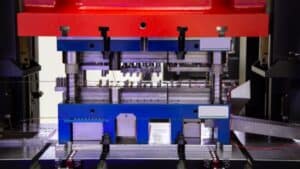
Draft angles are a key aspect of mold design that affect both the quality and manufacturability of injection molded parts. By applying a proper slope to vertical surfaces, you ensure your parts release easily from the mold without damage.
What is Draft Angles?
Draft angles are simply the taper or slope given to the sides of parts that are to be injection molded. Ideally, any vertical surface in your part design should include a draft to facilitate easier removal from the mold.
Why Draft Angles in Injection Molding is Important?
Draft angles are crucial for the injection molding process. Here are several specific reasons why:
- Easy part release: A draft helps to pop the part out of the mold smoothly.
- Surface quality: Without adequate draft, parts may show scratches or damage.
- Mold longevity: Proper draft angles reduce wear on the mold itself, leading to a longer mold life.
Minimum draft angle requirements vary depending on the part’s complexity and material, but even a 1-degree angle can make a significant difference.
Optimal draft angles are determined during the part and mold design stages and depend on the desired finish and details of the manufactured piece.
Multiple Considerations for Draft Angles

When designing parts for injection molding, material considerations play a pivotal role in determining the appropriate draft angles necessary for successful part ejection.
The choice of material significantly influences the flow and cooling properties during the molding process. For instance, thermoplastics are widely favored due to their versatility; however, each material exhibits unique characteristics that must be carefully assessed.
Softer materials typically require smaller draft angles, around 1 to 2 degrees, while stiffer materials necessitate larger angles, often 3 degrees or more, to facilitate mold release without damaging the part.
Additionally, the shrinkage rates of materials must be factored into the equation, as they dictate how much a part contracts during cooling. Higher shrinkage rates generally call for increased draft angles to prevent ejection issues, whereas lower shrinkage rates may allow for smaller angles.
For optimal results, it’s advisable to apply a draft angle of 1.5 to 2 degrees for parts up to 2 inches deep, while deeper or more complex geometries may require even steeper angles.
Furthermore, the surface finish of the part can significantly impact both aesthetics and functionality. Textured surfaces, for example, necessitate specific draft angles based on their depth; lighter textures can work with minimal angles of 1 to 1.5 degrees, while heavier textures may require angles of 3 degrees or more to ensure smooth ejection.
Balancing aesthetic requirements with functional performance is crucial, as a shiny, smooth finish might need a draft angle as small as 0.5 degrees, but too little draft can impede ejection and compromise part integrity.
Draft Requirements for Various Materials
| Material | Minimum Draft | Recommended Draft |
|---|---|---|
| Nylon | 0° | 1° |
| Polyethylene (PE) | 0.5° | 1.5° |
| Polyvinyl Chloride (PVC) | 0.5° | 1.5° |
| Polypropylene (PP) | 1° | 2° |
| Polycarbonate (PC) | 1.5° | 2° |
| Acrylonitrile Butadiene Styrene (ABS) | 1° | 2° |
| Polystyrene (PS) | 1° | 2° |
| Thermoplastic Elastomer (TPE) | 0.5° | 1.5° |
| Ethylene Vinyl Acetate (EVA) | 0.5° | 1.5° |
| High-Density Polyethylene (HDPE) | 1° | 2° |
Draft and Part Features

In injection molded parts, it’s essential to consider draft angles not only for the walls but also for all vertical features, such as ribs and bosses. The required draft angle is influenced by the depth of these features and their minimum thickness. The table below outlines the minimum thickness and corresponding draft angles for various feature depths.
| Feature Depth | Minimum Thickness / Draft Angles |
|---|---|
| 0.25 in. | 0.040 in. / 0.5° |
| 0.5 in. | 0.040 in. / 1°
0.060 in. / 0.5° |
| 0.75 in. | 0.040 in. / 2°
0.060 in. / 1° 0.080 in. / 0.5° |
| 1 in. | 0.060 in. / 2°
0.080 in. / 1° 0.100 in. / 0.5° |
| 1.5 in. | 0.080 in. / 2°
0.100 in. / 1° |
| 2 in. | 0.100 in. / 2° |
| 2.5 in. | 0.100 in. / 2.5° |
| 3 in. | 0.120 in. / 3° |
| 4 in. | 0.140 in. / 3° |
| 5 in. | 0.160 in. / 3.5° |
- Ribs: Typically require a minimum draft angle of 1° to ensure easy removal from the mold.
- Bosses: Should have at least a 2° draft angle when the depth exceeds 1 in. to facilitate molding.
- General Guidelines: As the depth of the feature increases, the minimum thickness should also increase to maintain structural integrity.
At Modie, we often create prototypes using computer-aided design (CAD) software. This allows us to visualize how the draft angles will function in practice. We may also conduct simulations to assess the ejection process and identify any potential issues before moving to production.
Collaboration with our manufacturing teams is essential to ensure that the designed draft angles align with the capabilities of our molding equipment. We consider factors such as mold design, cooling systems, and the type of injection molding process being used.
After thorough evaluation and testing, we make any necessary adjustments to the draft angles and finalize the design. If you have any questions or need assistance with your injection molding projects, our team is here to help!






